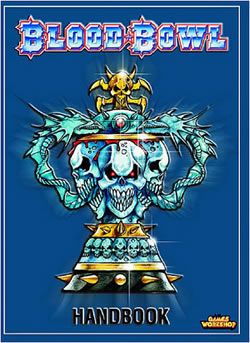Overview
Welcome to the pitch – where fantasy and football flawlessly fuse. This is a review of Blood Bowl: Living Rulebook, the game that redefines the meaning of ‘fantasy league.’ In this world, orcs, dwarfs, humans, and elves clash not for treasure or territory, but for touchdowns. We’ll dive headfirst into the nitty-gritty playbook, scrutinizing the fine balance between strategic team management, comprehensive player progression systems, and the dynamic, often chaotic in-game interactions that bristle with excitement. Buckle up your shoulder pads and grab your playbook; we’re about to dissect the mechanics that breathe life into this beloved tabletop staple.
How It Plays
Welcome to this exciting dive into the rough-and-tumble world of Blood Bowl: Living Rulebook! This game masterfully combines the strategic planning of a sports manager with the heart-pounding action of fantasy football. Let’s lace up and get a glimpse of how the bone-crushing competition unfolds from setting up to scoring for the win.
Setting Up
The initial set-up revolves around choosing your fantastical team—each with unique abilities—and placing your initially squadded team players strategically on the pitch. The gridiron before you is not just a battleground but a chessboard awaiting your master plan.
Gameplay
Starting with a kick-off, the gameplay spirals into a tumultuous series of turns where players move, block, pass, and strive to score touchdowns. Influenced by dice, the frenetic pace can pivot on the razor’s edge of risk versus reward, intensifying each coach’s decisions.
Winning the Game
To emerge victorious, you’ll need to outscore your adversary through nimble maneuvering, wise positioning, and a sprinkle of risk-tolerant audacity. However, remember, the true essence of victory in Blood Bowl resides just as much in crippling the other team as crossing into the end zone).
Want to know more? Read our extensive strategy guide for Blood Bowl: Living Rulebook.
Cunning Coaches and Clever Plays
Delving into the Blood Bowl: Living Rulebook, the strategic depth of team management never ceases to amaze me. Once my friends and I select our motley crew of players, whether we’re dealing with agile elves or brutish orcs, the tactical planning begins. Team composition and player placement are crucial and often lead to intense discussions.
On-field Tactics
Amidst the thrill of the game, mastering your team’s unique abilities ensures a dynamic battle for the ball. In that respect, recalling a game night where clever positioning turned the tide, highlights Blood Bowl’s strategy. Laughter and groans were shared as hopeless situations miraculoulsy turned into triumphant touchdowns!
Planning for the Long Game
Pacing your team’s strengths over the course of the league is fundamental. My proudest moment came when our underdog efforts paid off, winning a season against all odds. This level of team management fosters a profound bond with those cardstock heroes, making every victory (or defeat) more impactful. Transitioning from the strategic view, let’s march down the pitch to explore the intricate Player Progression System.
Nurturing Champions in Blood Bowl
In my playthroughs of Blood Bowl: Living Rulebook, I’ve always been fascinated by the depth of its Player Progression System. Watching my ragtag team grow from clumsy novices to gridiron legends never gets old.
Leveling Up the Squad
There’s something genuinely rewarding about the advancement process. Just last week, my Goblin Thrower learned ‘Diving Catch.’ Next thing I knew, he changed the game, catching a near-impossible pass that clinched our victory. Such enchanting moments showcase the strength of the progression system in orchestrating drastic team dynamics over time.
Customization and Uniqueness
Furthermore, customizing players to fit my team’s ethos has made every campaign personal and engaging. Opting for risky, strength-based improvements for linemen, or agility boosts for Blitzers – strategic enhancements have sewn together a narrative unique to my team’s journey.
Behind the Player Progression System lies another layer just as pivotal: the Interactive Gameplay Dynamics, a mechanic that I can’t wait to delve into next.
The Thrill of Interaction in Blood Bowl
Every tabletop warlord cherishes the moment when their carefully laid plans clash with an opponent’s strategies, where Blood Bowl: Living Rulebook truly excels. Bringing together mythical creatures from the Warhammer universe onto a fantasy football field, it demands not just strategic acumen, but also reactive ingenuity. The push and pull of every turn is punctuated by teamwork and dice rolls, basking in the unpredictable charm of interaction.
Collaborative Triumphs
One memorable game, with orcs and elves at loggerheads, fascinating dynamics unfolded right before our leather-clad dice cups couldn’t have predicted. Laughter ensued as a well-planned play turned into a comical scramble, showcasing how immersive social experiences are formed.
Pivotal Decisions
Moves anticipate counter-moves, blocking paths, passing the pigskin, every session is a showcase of interactive delight. In conclusion, if it’s an engaging, crowd-pleasing experience you seek, Blood Bowl: Living Rulebook receives my hearty recommendation. A hallmark of tabletop gaming: complex, infinitely replayable, and responsible for connections and moments you’ll reminisce about with your gaming group for eras to come.
Conclusion
Concluding our deep dive into Blood Bowl: Living Rulebook, it’s evident that this game melds strategic team management, a rich player progression system, and dynamic interactive gameplay into a compelling package that lives up to its considerable reputation. Typical sessions run the gamut from nail-biting chess-like movement calculations to the raucous laughter over a perfectly-implemented play—or an utterly botched one due to the infamous chaos of the dice gods. Whether it’s the thrill of scheming plays, the pride in nurturing an underdog player, or the sheer unpredictability of the game, Blood Bowl delivers an experience rich in variability and challenge.


